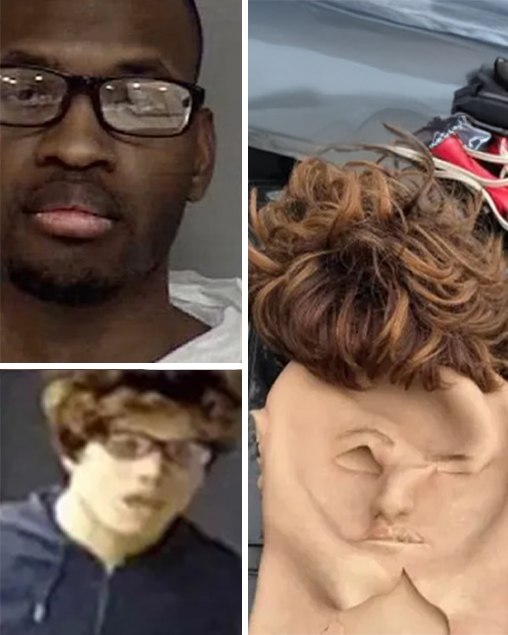When people think of masks, they often imagine costumes, disguises for entertainment, or props used to conceal identity in innocent ways. Rarely do they think of a mask as a weapon. Yet for Rockim Prowell, a man whose name has now become synonymous with deception and violence, a mask was not only a tool—it was his shield, his camouflage, and his most terrifying weapon. His story is one of horror that reads like the plot of a psychological thriller, yet it unfolded in real life across the city of Los Angeles, leaving behind a trail of terror, broken families, and unanswered questions.
Prowell’s crimes stunned the public not only because of their brutality but also because of the bizarre and disturbing way he concealed himself. He wore a lifelike silicone mask, one that transformed him into someone entirely different—so convincing that it made him appear to be of another race, a completely different man walking among his victims. Investigators described it as chilling. The mask allowed him to walk through neighborhoods and appear ordinary, while underneath lurked a predator whose actions shocked even seasoned detectives.
The mask became a metaphor for everything Prowell represented: duplicity, hidden menace, and the terrifying idea that evil can wear the face of someone you would never suspect. What unfolded behind that disguise was a story that revealed how a seemingly calculated killer used technology, charm, and violence to ensnare his victims.
In 2021, the first case that would later be linked to Prowell shook a quiet Los Angeles community. Miguel Angel King, a young man full of life and dreams, met someone through a dating app. Like millions of others, King believed he was making a simple connection. He had no idea that the person on the other side of the screen was orchestrating his doom. Days later, King was found dead, his life cut short under circumstances that would only become clear years later. The mask that Prowell wore, both literally and figuratively, made it nearly impossible at first to trace the crime back to him.
Two years later, in 2023, another case sent ripples through the city. Robert Gutierrez, also lured through a dating app, disappeared without a trace. His family waited desperately for answers, clinging to hope that he might return. But reality grew darker with each passing day. His body was never found, leaving his loved ones with the anguish of unanswered questions. What investigators did find, however, was a chilling clue—Gutierrez’s car, parked not in some distant alleyway or abandoned lot, but inside Prowell’s garage. That discovery would break open the case and solidify suspicions that had been forming around the man behind the mask.
If the story had ended there, it would already have been horrifying enough. But it didn’t. Prowell’s brutality continued, escalating in ways that revealed the depths of his violence. Another victim, who barely escaped, described a nightmare encounter that still haunts him. He had been beaten, tied up, robbed, and then, in a moment of desperation, tried to flee. What followed could have been the final chapter of his life. As he ran, broken and bleeding, he was run down by a car. Against all odds, he survived, and his testimony became one of the most damning pieces of evidence against Prowell. Without his voice, the full scope of this predator’s crimes might never have come to light.
When law enforcement pieced together the evidence, the picture they painted was one of cold, calculated evil. Prowell used dating apps not to find companionship, but as hunting grounds. He wore masks not to entertain, but to deceive and terrify. He carried out acts that prosecutors would later describe as “pure predation,” crimes meant not only to harm but to dominate and destroy. He was finally charged with multiple murders, attempted murder, robbery, and a host of other crimes that revealed the staggering extent of his violence.
The mask, in the end, became the symbol of the entire case. It embodied the very nature of Prowell’s crimes: hidden evil disguised as normalcy. To neighbors, he may have seemed like just another man. To strangers on the street, he may have appeared unremarkable. But beneath that exterior—whether it was his own face or the silicone mask—was something darker, something far more terrifying than anyone could imagine.
The chilling reality of Prowell’s crimes also raises larger questions about the era we live in. Technology has made it easier than ever to connect with strangers, to open doors to people we’ve never met in person. Dating apps, social media platforms, and online interactions all create opportunities—but they also create risks. Prowell exploited that trust, turning tools of connection into weapons of entrapment. His story forces us to confront uncomfortable truths about vulnerability in the digital age.
Families of the victims continue to grapple with the grief left behind. For the family of Miguel Angel King, the loss remains a wound that cannot be healed. For Robert Gutierrez’s loved ones, the absence of his body leaves them in a limbo that is perhaps even more painful than confirmed loss. And for the man who survived, the scars—both physical and emotional—are reminders of how close he came to becoming another name on a list of victims.
Court proceedings against Prowell have become a focal point for media and public attention. Each revelation in the courtroom peels back another layer of the mask he wore, exposing not just the crimes but the chilling psychology behind them. Prosecutors describe him as manipulative, remorseless, and dangerous. Defense attorneys, on the other hand, attempt to humanize him, suggesting struggles and complexities in his past. But for the families of victims, such arguments cannot erase the pain of lives stolen.
The story of Rockim Prowell is more than just a crime report—it is a cautionary tale. It reminds us that monsters do not always announce themselves. Sometimes they hide behind friendly profiles, convincing disguises, or even the most ordinary appearances. Sometimes they wear masks so convincing that the world doesn’t recognize them until it is too late.
As the trial moves forward, the city of Los Angeles—and indeed the nation—watches with a mixture of horror and fascination. True crime stories often grip the public, but this one resonates on a deeper level. It challenges our perception of safety, our trust in appearances, and our confidence in the tools we use to connect with others. It is a story that will be told for years to come, not only because of the brutality involved but because of the haunting image of a man hiding behind a lifelike mask while carrying out unspeakable acts.
In the end, the most terrifying thing about Rockim Prowell may not be the mask itself, but the fact that without it, he could have looked like anyone—your neighbor, your coworker, the man sitting quietly on the train. His crimes remind us that evil often hides in plain sight, wearing whatever face it needs to blend in, waiting for the moment to strike. And it is that thought, more than anything else, that will continue to haunt those who hear the story of the man who killed from behind the mask.

